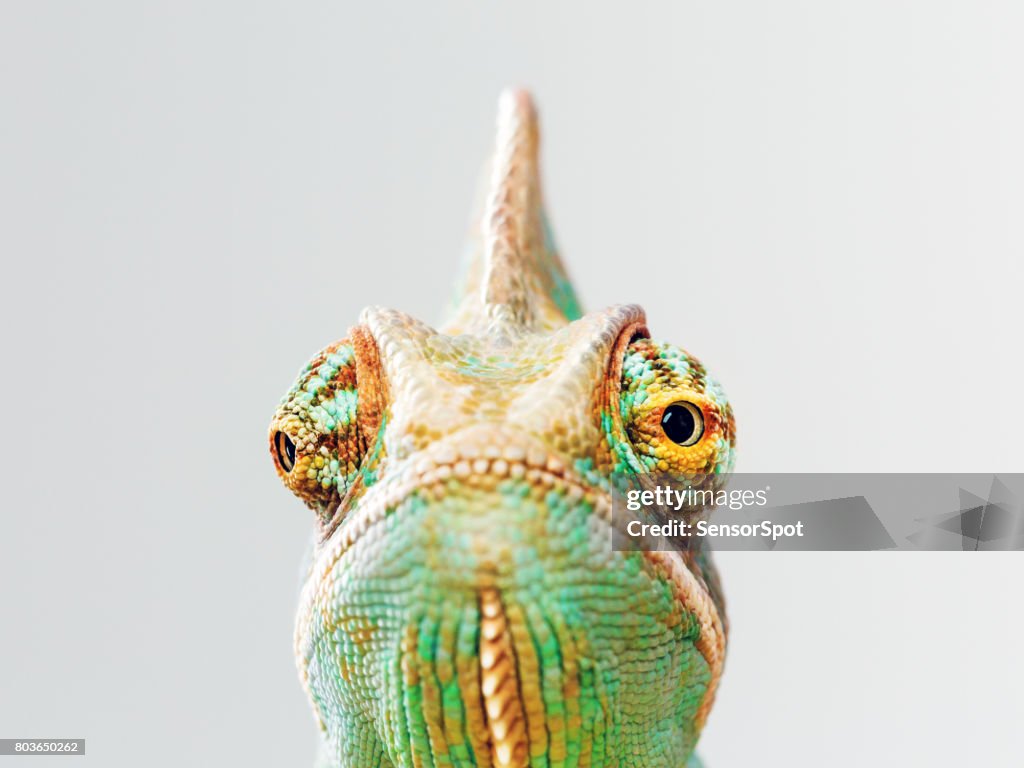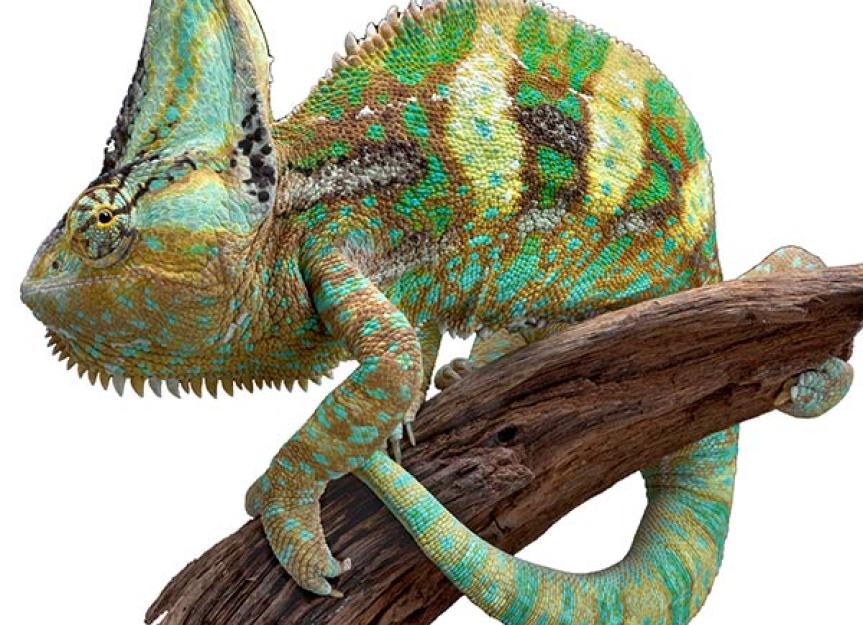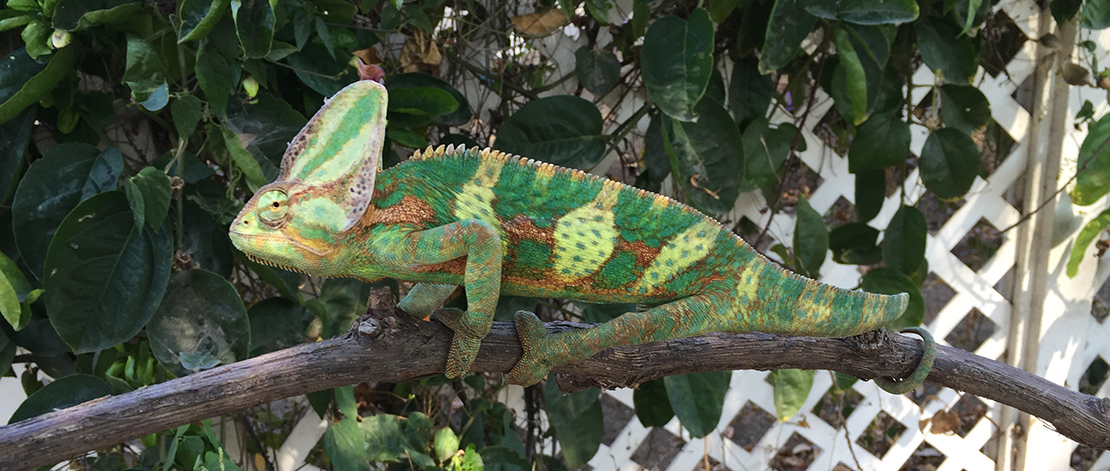A veiled chameleon typically reaches full size within one year. Growth rates can vary, influenced by diet and environment.
Veiled chameleons, known for their striking, colorful appearance and prominent casques, capture the fascination of reptile enthusiasts worldwide. These exotic creatures undergo a remarkable transformation as they mature from hatchlings to adults. Their journey to full size offers insights into their unique biology and care requirements.
Reaching maturity around the 12-month mark, these chameleons require careful attention to nutrition, adequate space, and controlled temperatures to thrive. Each stage of their growth offers a window into the meticulous balance of the ecosystem they require to reach their characteristic size and vibrant coloration. Fans of these captivating reptiles often find their growth process as mesmerizing as their ability to blend with their surroundings.

Credit: www.gettyimages.com
Hatchling To Juvenile: The Early Stages
Welcome to the fascinating journey from hatchling to juvenile in veiled chameleons. In this stage, they experience rapid growth and significant changes.
First Days After Hatching
Veiled chameleon hatchlings break free from their eggs with a voracious appetite. They begin feeding on tiny insects almost immediately. These first feeds are critical, as they provide the nutrients needed for their initial growth spurt. At this stage, proper humidity and temperature are vital for their survival and health.
Growth Rate In The First Months
The growth rate for veiled chameleons during their first months is astonishing. These creatures can double in size in mere weeks.
- First Week: Rapid initial growth is noticeable.
- First Month: Can grow up to 3 inches depending on diet and care.
- Subsequent Months: Growth continues at a brisk pace, with proper nutrition and habitat.
Feeding them a diet rich in calcium and vitamins is crucial for their bone development. Owners should monitor their chameleons closely to ensure a healthy growth trajectory.
Tracking Chameleon Growth
Every veiled chameleon owner loves watching their pet grow. Veiled chameleons undergo a fascinating growth journey from infancy to adulthood. Understanding this process is crucial for providing proper care. Keep a close eye on their development to ensure they are healthy and thriving.
Measuring Length And Weight
Track your chameleon’s size to gauge its growth.
Length: Measure from the snout to the tip of the tail.
Weight: Use a digital scale for accuracy.
Record these figures monthly. Keep a chart to visualize the growth pattern.
| Age (Months) | Length (cm) | Weight (g) |
|---|---|---|
| 0-3 | 7-10 | 5-20 |
| 3-6 | 15-20 | 30-50 |
| 6-12 | 20-30 | 100-150 |
| 12+ | 35-50 | 150-250 |
Signs Of Healthy Development
Observe these indicators to confirm your chameleon is growing well:
- Bright eyes: A sign of alertness and good health.
- Active color changes: Indicates normal stress response and mood changes.
- Regular eating habits: Consistent consumption of a varied diet is key.
- Firm, well-formed stool: Digestive health is essential to overall wellbeing.
Regular shedding indicates robust growth. Note the frequency and quality of the shed.
Diet’s Role In Maturation
The role of diet in a veiled chameleon’s growth is crucial. A balanced diet ensures they reach full size. Let’s explore optimal nutritional needs and feeding schedule variations.
Optimal Nutritional Requirements
For veiled chameleons to thrive, a diverse diet is essential. They need:
- Insects – They provide protein for growth.
- Calcium – Prevents bone issues and aids development.
- Vitamins – Particularly A, D3, and E for overall health.
Offer a mix of crickets, mealworms, and other safe insects. Dust these with a calcium supplement regularly. This prevents metabolic bone disease which can hamper growth.
Feeding Schedule Variations
Chameleons’ needs change as they grow. Here’s a simple guide:
| Age | Feeding Frequency | Portion Size |
|---|---|---|
| 0-6 Months | Twice daily | 8-12 insects |
| 6-12 Months | Once daily | 5-10 insects |
| Adult | Every other day | 2-5 insects |
Adjust as needed based on their appetite and growth. Baby chameleons eat more often to support rapid growth. Adult feeding helps prevent obesity.

Credit: chameleonacademy.com
Environmental Factors Influencing Growth
Raising a veiled chameleon can be a journey filled with excitement and wonder. These exotic creatures grow and thrive when their environment mimics their natural habitat. The behavior and development of your veiled chameleon depend significantly on environmental conditions. One aspect that fascinates owners is understanding the timeline to full size. Let’s explore the key elements that influence a veiled chameleon’s growth.
Temperature And Humidity Control
Veiled chameleons require precise conditions to flourish. The temperature and humidity within their space are crucial to their growth. Young chameleons need a basking spot with temperatures around 80-85°F during the day and a cooler area with temperatures of 70-75°F. At night, a drop to 60-70°F is essential. Humidity levels should remain at 50-70% to support hydration and shed their skin properly.
- Daytime Basking Spot: 80-85°F
- Cooler Area: 70-75°F
- Nighttime Temperature: 60-70°F
- Humidity: 50-70%
Habitat Setup And Its Impact
A well-designed habitat replicates the vertical space their natural environment provides. This setup is critical for their development. Use vertical branches and foliage to create a stimulating and supportive environment. This allows the chameleon to climb and explore, enhancing muscle growth and overall health. Provide regular feedings with nutrient-rich insects to ensure healthy growth. Calcium and vitamin supplements are vital to prevent metabolic bone disease, which can stunt growth. Incorrect lighting can also impact growth, so UVB light is fundamental to synthetize vitamin D3 for calcium absorption.
| Habitat Feature | Impact on Growth |
|---|---|
| Vertical Space | Enables muscle development and exercise |
| Nutrient-Rich Food | Essential for proper growth and health |
| Supplements | Prevents bone issues, aids in growth |
| UVB Lighting | Crucial for vitamin D3 synthesis and calcium absorption |
Recognizing Maturity Milestones
Watching a veiled chameleon grow is fascinating. Knowing when they reach full size becomes crucial. Different factors influence growth, from diet to environment. Typically, chameleons can reach their mature size within 12 to 18 months. Here’s how to spot those all-important maturity milestones.
Physical Indicators Of Maturity
Visual signs can indicate that a veiled chameleon is mature. Look for a length between 17 to 24 inches from snout to tail tip in males. Females usually measure smaller. Another sign is the casque, or helmet-like ridge, on their head. In adults, it is notably more pronounced. Scales become more defined, and their coloring grows brighter with maturity.
Weight gain is another indicator. A full-grown male can weigh between 140 to 180 grams. Females usually weigh less. An increase in body girth also suggests maturity, especially in females that could become gravid (holding eggs).
Behavioral Changes In Adult Chameleons
As chameleons mature, behaviors change. Adult chameleons often become more territorial. You might notice males displaying brighter colors to assert dominance or attract a mate. They become less tolerant of other chameleons and could show more aggression. Mature females may show receptive or non-receptive colors to males, indicating their readiness to mate.
Adult chameleons often exhibit increased confidence and curiosity in their surroundings. They might explore more and can handle handling better than juveniles, especially if accustomed to gentle interaction. During mating season, a clear sign of maturity is the display of courtship behaviors, like head bobbing and specific color changes.
Health Concerns During Growth
As your veiled chameleon grows, keep an eye out for health issues that could slow its progress. These fascinating reptiles can face various problems that hinder their journey to full size. Early detection and care are crucial. Let’s explore the common ailments and preventive actions you need to know.
Common Ailments To Watch For
Veiled chameleons are hardy creatures, but they have their fair share of challenges. Here are the top health concerns:
- Metabolic Bone Disease (MBD): Caused by calcium deficiency or lack of UVB light.
- Respiratory Infections: Often due to poor ventilation or low temperatures.
- Parasites: Internal or external invaders can affect growth and well-being.
- Dehydration: Critical for chameleons, shows in a sunken casque or eyes.
Preventive Care And Regular Check-ups
Preventive measures ensure your veiled chameleon thrives. Aim for these best practices:
- Right Habitat: Invest in proper lighting, temperature, and humidity controls.
- Balanced Diet: Offer a variety of insects dusted with supplements.
- Hydration: Chameleons require regular misting to stay hydrated.
- Veterinary Visits: Schedule annual exams to catch any health issues early.
By maintaining these standards, your veiled chameleon is more likely to reach full size in good health.

Credit: www.petmd.com
Frequently Asked Questions For How Long Does It Take For A Veiled Chameleon To Reach Full Size?
How Long Does It Take For A Veiled Chameleon To Be Fully Grown?
A veiled chameleon typically reaches full size within 12 to 18 months.
At What Age Do Veiled Chameleons Reach Maturity?
Veiled chameleons typically reach maturity between 8 to 12 months of age. Males generally mature slightly earlier than females.
How Can I Tell The Age Of My Veiled Chameleon?
To determine the age of a veiled chameleon, observe its size and coloration; juveniles are smaller with duller colors. Consult a veterinarian or refer to growth charts for precise aging.
What Age Do Chameleons Change Color?
Chameleons start changing colors at a few months old as part of their camouflage, communication, and temperature regulation abilities.
Conclusion
Understanding the growth timeline of veiled chameleons is essential for proper care. Typically, these creatures achieve full size within 12 to 18 months. Providing optimal nutrition and habitat conditions can ensure a healthy development rate for your veiled chameleon. Remember, patience and attentiveness are key to nurturing your colorful companion to its splendid, full-grown state.

